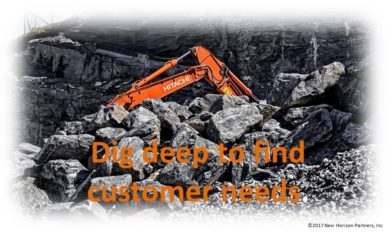Strategic differentiation is achieved by providing a unique or different value offering to customers as compared to competitors. A strategy of differentiation is based on developing a deep understanding of customers’ needs and then meeting those needs in a unique way. The value offering is the whole package of product, service, and relationship benefits. The price to the customer comes into play when the customer evaluates the benefits or value of the offering. A frequent mistake that companies make is not understanding the needs of the customer in sufficient depth. Often product suppliers only look at product differentiation based on the benefits provided by the product. In the same way, service suppliers sometimes look too narrowly at the service provided.

A consulting project from some time ago demonstrates the need to dig deep in understanding customer needs. I had done a couple of small projects for this particular client regarding product offering and go to market decisions. It had surprised me how successful they were in their primary business when it appeared to be a completely commodity product. My curiosity was satisfied in the next project. The owner of the company asked that I identify customer needs and help them further refine their business strategy. Through the usual process of in-depth interviews of customers and other industry participants, I discovered why my client was able to garner a large share of the market for a commodity product at a premium price. This competitive position was in the face of growing low-cost international competition and competitors that had various advantages in terms of manufacturing capabilities.
This client’s product was sold through an industrial distribution channel and generally combined with other products in the distributor’s final sale. Through the interview process we identified that the client’s product was a small portion of the sale amounting to a few dollars in a multi-hundreds total sale. The customer’s (the distributor) primary need was that the purchase of these ancillary parts was as painless as possible; it was really a matter of transaction cost. The price of my client’s product was so low insignificant compared to the total package being assembled by the distributor that their concern was simply that one phone call or order completion was all that was required. A second phone call to check on delivery, get an authorization for return goods, correct an error, or anything else would far outweigh any savings from a lower priced competitor.
The client’s customer service function was outstanding because they had a customer service manager who was a bit of a drill sergeant when it came to serving the customer. She understood the customer’s expectations and assured that they were being met. She was a good leader in that she developed a shared vision within the customer service function that the customer should never be disappointed or inconvenienced and she empowered her customer service reps to make the necessary decisions to carry out this vision.
The client’s strategy, the “where and how to compete”, embodied this vision. The “where” was obvious; they sold these particular, well-defined products through an industrial distribution channel. The “how to compete” was all about serving the customer and assuring that they provided the lowest cost of transaction with their impeccable service.
The lesson to be learned here is this: When a customer is buying a widget, the customer need is not for a widget. The customer need, in fact, is for the benefits that the widget will provide and for the benefits that the accompanying service and relationship will afford the customer. When seeking to determine customer needs and to defining a competitive strategy that will provide value to the customer and a profitable return to the organization, the firm needs to dig deep. Henry Ford is quoted as saying, “If I had asked people what they wanted, they would have said faster horses.” Steve Jobs said something to the effect that you can’t ask customers what they want, because they don’t know. Both of these thoughts are the same, in understanding customer needs one must dig deep to find the inner motivation and desire that even the customer might not recognize. Then the organization must develop a solution where the benefits derived from the product, service, and relationship meet those deeper needs.
Do you understand the real needs of your customers? Does your strategy move you towards a competitive advantage in meeting those needs?

Add your comment